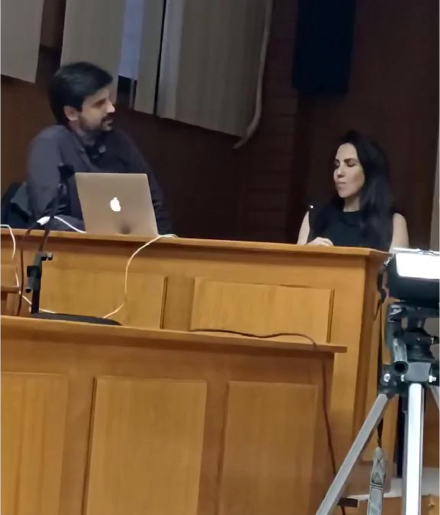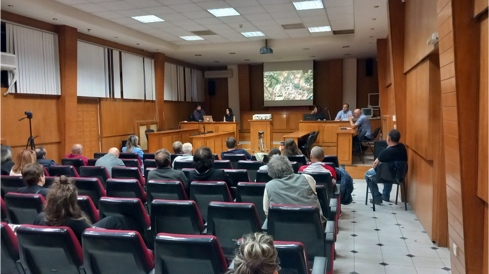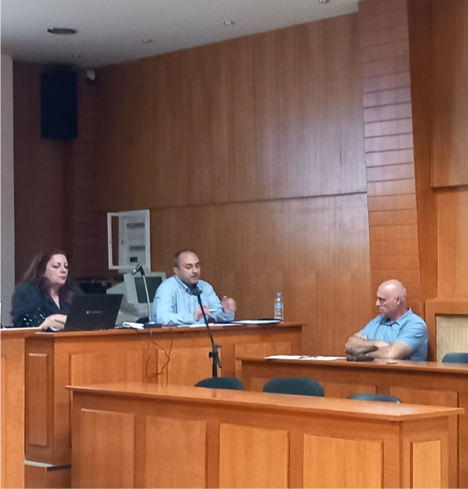Carbon Tierra Biennale 1 Conference
29 September 2024
Seminar/Round Table Discussion at the Ptolemaida Labour Centre, (Meeting Room)
In the Frame of Carbon Tierra Biennale.
Opening Address by the Deputy Mayor of Culture of Eordaia Mr. Ioannides Constantinos
Speakers in order of presentation:
Klitsa Antoniou (Visual Artist / Academic)
Annita Koutsonanou (Architect Engineer)
Fotis Gaitanis (Civil Engineer)
Nikos Lyssaridis (Deputy Regional Governor of Entrepreneurship & Transport of Western Macedonia)
Moderated by George Lazoglou
Press
■ artfacts.net
■ spititiskyprou.gr
■ cut.ac.cy
■ gr.euronews.com
■ eetf.uowm.gr
■ kilowartplatform.gr
■ prlogos.gr
■ facebook.com/events
■ paideia-news.com
■ archisearch.gr
■ kozan.gr
■ kozan.gr
■ philenews.com
■ neaptolemaidas.gr
■ ertnews.gr
■ tharos.gr
■ e-ptolemeos.gr
■ prlogos.gr
■ e-ptolemeos.gr
■ youtube.com
■ msn.com
■ youtube.com
■ fractalart.gr
■ xronos-kozanis.gr
■ kozan.gr
■ kastoria.news
■ parallaximag.gr
Through their partnership and collaboration, kilowArt platform and Cut Contemporary Fine Arts Lab are presenting the inaugural Carbon Tierra Biennale in Ptolemaida City, Greece. The Biennale is directed by an international multidisciplinary research team and is supported by a group of scientific and artistic advisors from Greece and abroad.
Ptolemaida City, throughout its historical trajectory from the latter part of the 20th century to the present, has been associated with coal mining and the establishment of steam power plants for electricity generation. The region’s mines testify to the largest mining activity of the Balkan Peninsula and the frenzied industrial exploitation of underground wealth resulted in socio-economic and political distortions. With the violent advent of the post-lignite period and in combination with the economic crisis of the last ten years and more, the concept of development in the region has been radically redefined.
At the same time, the lasting environmental footprint of mining and industrial activities, along with the absence of compensatory policies for sustainable development, resulted in the degeneration of the landscape and the devaluation of ecological practices, on the altar of profit and energy sufficiency from land exploitation.
Drawing on the work of art historian Herman Bashiron Mendolicchio, Wounded Landscapes, Tense Equilibriums, and Broken Connections: Art, Earth, and Human (Univ. of Barcelona, 2023) the inaugural edition of the Biennale sets its sights on the Wounded Landscapes found in industrial and post-industrial communities. It focuses on the abusive practices that have been followed and allowed and how they shape and determine our relationship with the urban landscape and the natural environment.
The Carbon Tierra Biennale, by applying extensive, retrospective, creative and participatory research into mining practices and their impact, reinforces our collective identity and our intangible cultural heritage that is largely unexplored. It aims to activate and enrich cultural and artistic research and creation beyond urban centers and metropolitan areas and include peripheral locations by integrating the rural landscape into future artistic processes. It promotes initiatives for local participants and stakeholders to identify specific areas and actions suitable for reinterpretation. At the same time, it attempts, through the perspective of contemporary art and living culture, to re-envision and expand concepts such as those of advancement and social cohesion by examining the contemporary socio-economic reality.
“What is this destructive force we have inside that does not show us the limits and impacts of our actions? What is preventing us from acting in a sustainable way for the future of the Earth and its current and future inhabitants?” (Mendolicchio, 2023). The Biennale pursues to raise questions, seeks to provide openings for the public to contemplate, critique, and reposition damaged landscapes and the deceptive narratives of advancement and economic expansion, redefining the price of such expectations. The Biennale looks for an interactive and dynamic connection between historical mining heritage and innovative contemporary art and artistic practice. In addition, it promotes the creation of connections with other mining communities and their environment, developing a global network of cultural exchange and dialogue.
“Art can propose new tools, it can change the narrative, it can reflect on challenges from different perspectives, and it can nurture movements, but the hegemony of the exploitation system in which we live (the one that can provoke the human fatality and the planet’s catastrophe) requires a broader awareness. Surrounded by wounded landscapes, humanity must find the way to allow and accept a functioning system of co-existence. As stated by author Cal Flyn: ‘This is a corrupted world, yes – one long fallen from a state of grace – but it is a world too that knows how to live. It has a great capacity for repair, for recovery, for forgiveness – of a sort – if we can only learn to do it so.’ Switch off the light. Don’t touch. Stay silent. Leave nature alone.” (Mendolicchio, 2023).
From 27 to 29 September, the Carbon Tierra Biennale will include art performances and video art by international artists.
On Sunday, September 29, a panel discussion will take place at the Labor center of the Municipality of Eordaia, while parallel actions that will include exhibitions and installations of local artists in closed shops of the city will further enrich the Biennale’s program.
(All extracts are from Herman Bashiron Mendolicchio, ‘Wounded landscapes, Tense Equilibriums, and Broken Connections: Art, Earth and Humans’, Coolabah, Nr 35, 2023, ISSN 1988-5946. Online journal of the Observatory: Australian and Transnational Studies Centre (OCEAT), University of Barcelona, 2023. Available online at: https://revistes.ub.edu/index.php/coolabah/article/view/46161)
Next Project
VITAL





